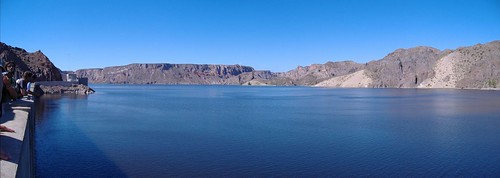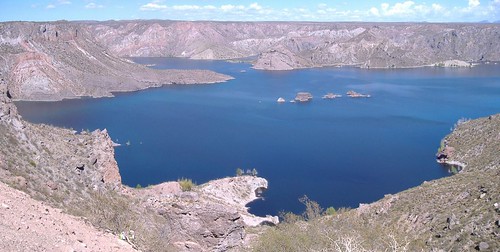Mendoza, like most of the places just east of the Andes, is extremely dry. The humidity that blows in from the Pacific Ocean mostly causes precipitation in Chile and doesn't make it across the nearly 7,000-meter-high Andean ranges. However, there are a number of important glacial rivers that grow when the ice melts up there. The people of Mendoza have taken advantage of these rivers: they've dammed them in several points, forming reservoirs (artificial lakes), deriving water for irrigation, and generating hydroelectricity. I visited several of these reservoirs during my vacations.
The first one is the largest dam, called El Nihuil. It is the first dam on the Atuel River, near the city of San Rafael. The dam is located at about 1,250 m above mean sea level, just at the point when the river enters a canyon.

El Nihuil traps the waters and derives the flow through a series of tunnels excavated in the mountains (they took 25 years to complete!), to a series of four hydroelectrical power stations downstream. The original course of the Atuel along the canyon is barely visible; the river vanishes completely in many places.
Then you have the Valle Grande reservoir:

The rock formations in the center of the lake receive the name of El Submarino ("The Submarine") and, according to our tour guide, they're in every touristic pamphlet about San Rafael.
Once the Atuel has fulfilled its duties as a hydropower generator, it can be used for other activities, such as rafting. We did some of that, though it was only level II in the scale of river difficulty (with a maximum of VI for rivers that cannot be navigated at all).
Besides these huge engineering works, the importance of water can be seen throughout Mendoza. All the cities have ditches running along each side of the street that serve as irrigation channels; every now and then you find a system to manually stop the flow. The ditches (acequias) turn into channels and more ditches in the countryside. Of course, there aren't many thing that can grow there easily — mostly grapes and olives. I assume there must be some control as to how each farmer gets his or her water from the collective ditches.
In Mendoza City people are already complaining that the recently-built Potrerillos dam, with its 14-km-long reservoir, is making the town more humid. There are actually mosquitoes in Mendoza now; I spent two nights there with a humid heat that reminded me of Rosario. Further south the problem is not that big, and in Malargüe the aridness of the landscape was impressive. The Malargüe River, which is the most important in an area of more than 30,000 km², would be called a little stream here in the Argentine littoral, but it manages to serve a small city... provided you don't take long showers. In the places I stayed, the toilets didn't flush a large discharge automatically — you needed to keep pressing the thingy in order to keep the water flowing.













No comments:
Post a Comment
Note: Only a member of this blog may post a comment.